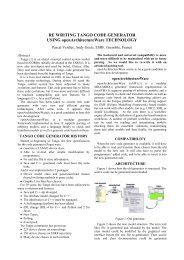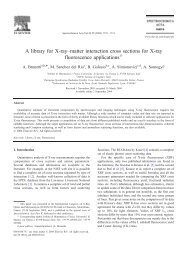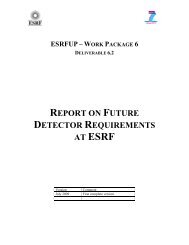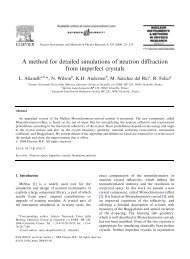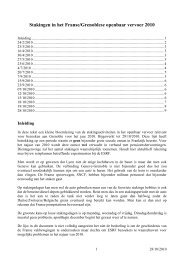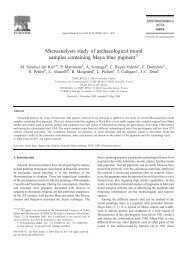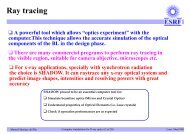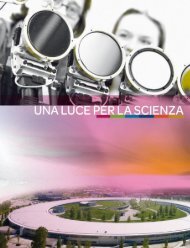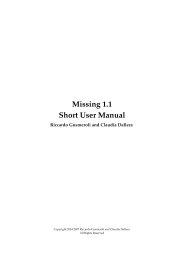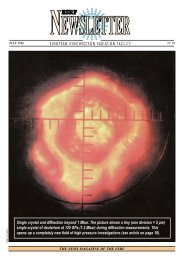New Scientific Opportunities at the European Synchrotron Radiation ...
New Scientific Opportunities at the European Synchrotron Radiation ...
New Scientific Opportunities at the European Synchrotron Radiation ...
You also want an ePaper? Increase the reach of your titles
YUMPU automatically turns print PDFs into web optimized ePapers that Google loves.
<strong>European</strong> <strong>Synchrotron</strong> Radi<strong>at</strong>ion Facility Long-Term Str<strong>at</strong>egy 7 July 2006<br />
• regular organis<strong>at</strong>ion of intern<strong>at</strong>ional nanoscience meetings<br />
• setting up a central d<strong>at</strong>abase for various nanofocusing optics (CRL, Fresnel<br />
zone pl<strong>at</strong>es, mirrors, crystals etc.).<br />
Combin<strong>at</strong>ion of microanalytical techniques include:<br />
• Microtomography combined with various spectroscopic techniques (e.g.<br />
XRF/XRD/XANES/EXAFS) should be pursued with nanoscopic resolution. In<br />
this respect <strong>the</strong> stability of micro- (nano-) EXAFS represents a serious<br />
problem even on <strong>the</strong> micrometer scale, which should be taken into account<br />
during <strong>the</strong> developments of micro-spectroscopy beam lines.<br />
• Combin<strong>at</strong>ion of X-ray imaging with electron microscopy, which would be very<br />
useful for nanoimaging and sample visualis<strong>at</strong>ion when optical microscopy<br />
reaches its <strong>the</strong>oretical limits of resolution.<br />
Fur<strong>the</strong>r developments are needed in <strong>the</strong> field of d<strong>at</strong>a evalu<strong>at</strong>ion for phase-contrast<br />
imaging techniques. A task-force should be cre<strong>at</strong>ed for improving <strong>the</strong> coordin<strong>at</strong>ion<br />
among phase-retrieval techniques developments. On-line d<strong>at</strong>a reduction/evalu<strong>at</strong>ion<br />
in general is an important issue for imaging and scanning micro-spectroscopy, and its<br />
development should be fur<strong>the</strong>r pursued.<br />
Oversubscription is a serious issue <strong>at</strong> imaging beamlines, <strong>the</strong>refore <strong>the</strong> increase in<br />
<strong>the</strong> number of end-st<strong>at</strong>ions will be a positive development. The possibility of external<br />
staffing via partnerships should be considered, possibly via 7 th framework EUprojects.<br />
Report on <strong>the</strong> discussion held during <strong>the</strong> parallel session of <strong>the</strong> Surface and<br />
Interface Science Group: Chris Lucas (UO), Joerg Zegenhagen (ESRF)<br />
Christian Mocuta (ID1) gave <strong>the</strong> first present<strong>at</strong>ion showing examples of micro-beam<br />
diffraction studies of nanotubes and Ge pyramids on Si and coherent X-ray diffraction<br />
measurements from Au microcrystals. Joerg Zegenhagen <strong>the</strong>n summarised <strong>the</strong><br />
group activities on beamlines ID1, ID3 and ID32. Olaf Magnussen (University of Kiel),<br />
gave an excellent introduction to <strong>the</strong> electrochemical interface and <strong>the</strong>n described<br />
some recent results concerning Au homoepitaxy, hydrogen evolution on Pt and liquid<br />
mercury electrodes.<br />
The talks were followed by detailed question and answer sessions from a packed<br />
audience. The ESRF long term str<strong>at</strong>egy (LTS) document was summarised by Chris<br />
Lucas as a lead-in to <strong>the</strong> discussion session where <strong>the</strong> questions summarised <strong>at</strong> <strong>the</strong><br />
head of this Section were addressed.<br />
This gener<strong>at</strong>ed a gre<strong>at</strong> deal of discussion as to <strong>the</strong> potential limit<strong>at</strong>ions in studying<br />
single nanoparticles and exactly how long a beamline would have to be in order to<br />
have sufficient space around a sample. The highest priority for infrastructure support<br />
was deemed to be detector development. It was pointed out th<strong>at</strong> <strong>the</strong>re appeared to<br />
be a gap in <strong>the</strong> accessible energy range of synchrotron sources in <strong>the</strong> range 20-50<br />
keV and <strong>the</strong> ESRF could fill this gap. Looking <strong>at</strong> <strong>the</strong> future it was noted th<strong>at</strong> <strong>the</strong> LTS<br />
describes a str<strong>at</strong>egy th<strong>at</strong> would be governing experiments performed in 5-10 years. It<br />
48



